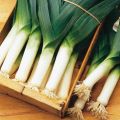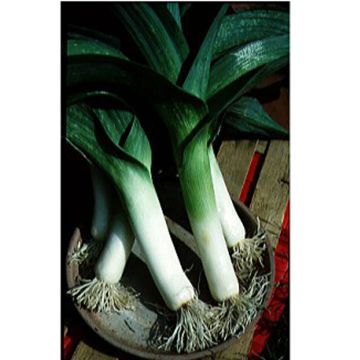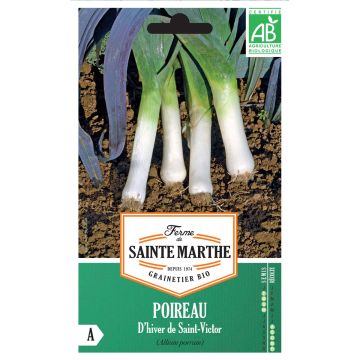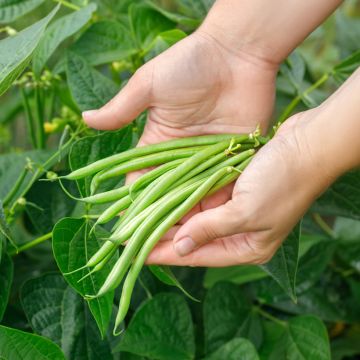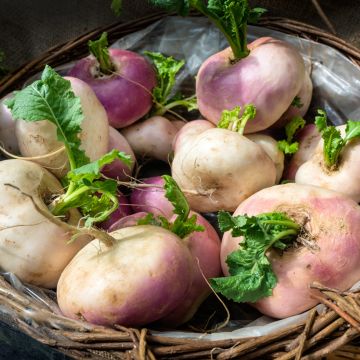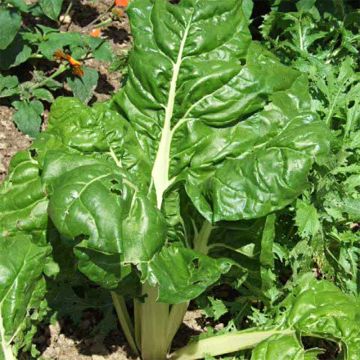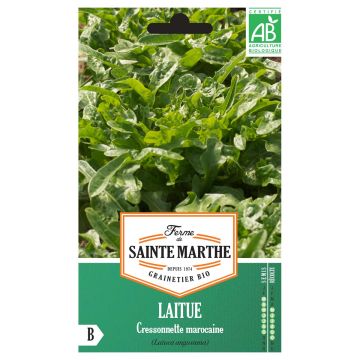

Leek Collection - 4 Varieties for Long Harvests
Leek Collection - 4 Varieties for Long Harvests
sowing done 3 weeks ago in the greenhouse with the first packet, to this day not a single shoot. RESPONSE FROM PROMESSE DE FLEURS We are sorry as we attach great importance to the quality of our young plants as well as their growth, if you encounter any problems, do not hesitate to contact us at 03.61.76.08.10 and we will proceed with replacement or refund.
Danielle Jeanjean, 11/04/2016
This item cannot be shipped to the selected country
Dispatch by letter from €3.90
More information
Schedule delivery date,
and select date in basket
This plant carries a 6 months recovery warranty
More information
We guarantee the quality of our plants for a full growing cycle, and will replace at our expense any plant that fails to recover under normal climatic and planting conditions.
Seed-only orders are dispatched by sealed envelope. The delivery charge for seed-only orders is €3.90.
Collection items (4 plants)
Description
This seed collection brings together 4 excellent leek varieties for long harvests from early summer until early spring. The collection consists of the following varieties in individual seed packets: 'Gros Jaune du Poitou', 'Electra', 'Monstrueux d’Elbeuf' and 'De Saint Victor'.
'Gros Jaune du Poitou' leek is an early-maturing, fast-growing French summer variety. It produces short, white stems and light green to almost yellow leaves. Exceptional tender texture. Sow from February to April and harvest from July until the first frosts.
'Electra' leek is a fast-maturing, early variety suitable for late summer and autumn harvests. It forms long blue-green leaves and a thick, fairly short stem. Excellent, fine flavour. Sow from February to May and harvest from July to December.
'Monstrueux d’Elbeuf' leek is a very early-maturing French heirloom variety. It produces huge, short and thick, stems topped with tall, vigorous light green leaves. Excellent, strong flavour and tender texture. Sow from January to May and enjoy long harvests from June to December.
'De Saint Victor' leek is a very hardy winter variety is particularly resistant to allium leek miner. It forms dense blue-green leaves with a slight purple tinge and a thick, long non-stringy stem. Excellent, fine flavour. Sow from March to May and harvest from October to March.
The leek or Allium porrum is a biennial herbaceous plant belonging to the Alliaceae family. Originally from the Middle East, it was consumed by the Ancient Egyptians as far back as 1500 BC. It was also a popular food in Ancient Rome. Its appearance was similar to that of its cousin the onion, with a very thin shaft and a swollen bulb. By the Middle Ages, leeks were commonly grown throughout Europe with Wales even making the leek its national emblem.
The leek has long, broad, sheathing blue-green or dark green leaves which grow closer together and become whiter in colour towards the bulbous end, forming the so-called “stem”. The stem owes its lighter colour to the fact that it is generally buried (blanched) or shielded from sunlight by the outer leaves. It is thought to be the tastiest part, with its very fine flavour and tender texture. At the end of the second year, leeks produce a flower "stalk" topped by a purple spherical umbel, about the size of a tennis ball.
The leek is a must-have in the kitchen garden! It has a delicious flavour, similar to onion and asparagus (so much so that in France it has even been named the “poor man’s asparagus”!). When cooked, its flavour becomes sweeter. It is generally grown for its white stem and rootlets, although the greener tops can be used in soups. Leek is a popular vegetable throughout the world. In France it is often sautéed in butter then added to quiche, eaten cold with vinaigrette, made into potato and leek soup etc. In Japan it is used in many dishes including sushi, sashimi or stir-fries with sesame seeds or ginger.
It is a very hardy vegetable that can be sown from February to August and harvested nearly all year round. Some winter varieties can withstand temperatures below -15 or even -20° C. Leek is a good source of fibre, vitamins C and B and sulphur compounds. It is an efficient antioxidant, and can help lower blood cholesterol levels and ease digestion.
Harvesting: Harvest your leeks as and when required, generally 5 to 8 months after sowing. Pull gently and firmly on the upper leaves, being careful not to damage the stem. You can use a garden fork or spade as a lever if the leeks are proving too difficult to pull up by hand.
Storage: Leeks will keep for up two weeks in the refrigerator, and almost 3 months in the freezer. Blanch them for a few minutes, run them under cold water, dry them then put them in freezer bags in the freezer for later use.
Good to know: Leeks and carrots are great companion plants as carrot fly hates leeks and leek fly hates carrots! Tomatoes, lettuces and strawberries are also good companion plants for leeks. Avoid growing leeks next to onions, beetroots and beans.
Report an error about the product description
Harvest
Plant habit
Foliage
Botanical data
Cucurbitaceae
Cultivar or hybrid
Annual
Other Leek seeds
Planting and care
The leek is often thought of as a winter vegetable, although summer varieties do also exist. It has a fairly long growth period that consists of several phases.
Soil preparation: leeks enjoy deep, rich soils with a good supply of organic matter. Make sure to amend your soil several months in advance as leek plants suffer from recent soil amendments. Choose an open, sunny location in cool, well-loosened soil.
Sowing: Dig a 2 cm deep furrow and sow a small quantity of seeds every centimetre. Cover with sowing mix and firm down lightly with a rake. From February to May depending on the climate, sow under cover (cold frame, low tunnel, etc.). Germination takes between fifteen days and three weeks. When the young plants are about 15 cm tall and the thickness of a pencil, they are ready to be transplanted. Before doing so, they should be carefully lifted and left to dry on the ground, in the shade for a couple of days. This helps reduce the "leeky" smell and prevent your crops from being infested by the onion fly.
Transplanting: before transplanting, trim the roots 2-3 cm below the bulb and trim the young leaves a few cm above the stem. This stimulates the roots and prevents the plants’ precious water reserves from evaporating via the leaves.
Next, make holes about 15 cm deep, spaced 15-20 cm apart in all directions. Gently drop the baby leeks into the holes. The white part should be completely buried. Water generously as this will help seal all air gaps around the main stem. As leeks thrive in nitrogen-rich soil, mulch with freshly mowed grass between the rows. About a fortnight to a month later, the seedlings will start to pick up strength and grow. Hilling up the plants keeps the stem out of the sunlight, ensuring that it remains white and tender (blanching).
Seedlings
Care
Intended location
-
, onOrder confirmed
Reply from on Promesse de fleurs
Vegetable seeds
Haven't found what you were looking for?
Hardiness is the lowest winter temperature a plant can endure without suffering serious damage or even dying. However, hardiness is affected by location (a sheltered area, such as a patio), protection (winter cover) and soil type (hardiness is improved by well-drained soil).

Photo Sharing Terms & Conditions
In order to encourage gardeners to interact and share their experiences, Promesse de fleurs offers various media enabling content to be uploaded onto its Site - in particular via the ‘Photo sharing’ module.
The User agrees to refrain from:
- Posting any content that is illegal, prejudicial, insulting, racist, inciteful to hatred, revisionist, contrary to public decency, that infringes on privacy or on the privacy rights of third parties, in particular the publicity rights of persons and goods, intellectual property rights, or the right to privacy.
- Submitting content on behalf of a third party;
- Impersonate the identity of a third party and/or publish any personal information about a third party;
In general, the User undertakes to refrain from any unethical behaviour.
All Content (in particular text, comments, files, images, photos, videos, creative works, etc.), which may be subject to property or intellectual property rights, image or other private rights, shall remain the property of the User, subject to the limited rights granted by the terms of the licence granted by Promesse de fleurs as stated below. Users are at liberty to publish or not to publish such Content on the Site, notably via the ‘Photo Sharing’ facility, and accept that this Content shall be made public and freely accessible, notably on the Internet.
Users further acknowledge, undertake to have ,and guarantee that they hold all necessary rights and permissions to publish such material on the Site, in particular with regard to the legislation in force pertaining to any privacy, property, intellectual property, image, or contractual rights, or rights of any other nature. By publishing such Content on the Site, Users acknowledge accepting full liability as publishers of the Content within the meaning of the law, and grant Promesse de fleurs, free of charge, an inclusive, worldwide licence for the said Content for the entire duration of its publication, including all reproduction, representation, up/downloading, displaying, performing, transmission, and storage rights.
Users also grant permission for their name to be linked to the Content and accept that this link may not always be made available.
By engaging in posting material, Users consent to their Content becoming automatically accessible on the Internet, in particular on other sites and/or blogs and/or web pages of the Promesse de fleurs site, including in particular social pages and the Promesse de fleurs catalogue.
Users may secure the removal of entrusted content free of charge by issuing a simple request via our contact form.
The flowering period indicated on our website applies to countries and regions located in USDA zone 8 (France, the United Kingdom, Ireland, the Netherlands, etc.)
It will vary according to where you live:
- In zones 9 to 10 (Italy, Spain, Greece, etc.), flowering will occur about 2 to 4 weeks earlier.
- In zones 6 to 7 (Germany, Poland, Slovenia, and lower mountainous regions), flowering will be delayed by 2 to 3 weeks.
- In zone 5 (Central Europe, Scandinavia), blooming will be delayed by 3 to 5 weeks.
In temperate climates, pruning of spring-flowering shrubs (forsythia, spireas, etc.) should be done just after flowering.
Pruning of summer-flowering shrubs (Indian Lilac, Perovskia, etc.) can be done in winter or spring.
In cold regions as well as with frost-sensitive plants, avoid pruning too early when severe frosts may still occur.
The planting period indicated on our website applies to countries and regions located in USDA zone 8 (France, United Kingdom, Ireland, Netherlands).
It will vary according to where you live:
- In Mediterranean zones (Marseille, Madrid, Milan, etc.), autumn and winter are the best planting periods.
- In continental zones (Strasbourg, Munich, Vienna, etc.), delay planting by 2 to 3 weeks in spring and bring it forward by 2 to 4 weeks in autumn.
- In mountainous regions (the Alps, Pyrenees, Carpathians, etc.), it is best to plant in late spring (May-June) or late summer (August-September).
The harvesting period indicated on our website applies to countries and regions in USDA zone 8 (France, England, Ireland, the Netherlands).
In colder areas (Scandinavia, Poland, Austria...) fruit and vegetable harvests are likely to be delayed by 3-4 weeks.
In warmer areas (Italy, Spain, Greece, etc.), harvesting will probably take place earlier, depending on weather conditions.
The sowing periods indicated on our website apply to countries and regions within USDA Zone 8 (France, UK, Ireland, Netherlands).
In colder areas (Scandinavia, Poland, Austria...), delay any outdoor sowing by 3-4 weeks, or sow under glass.
In warmer climes (Italy, Spain, Greece, etc.), bring outdoor sowing forward by a few weeks.


































